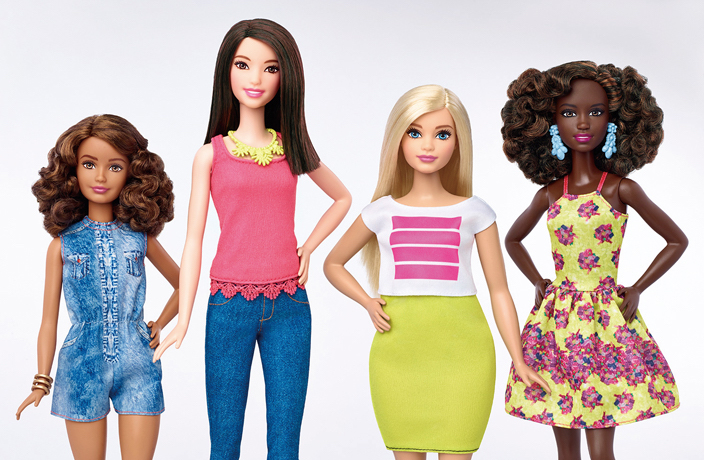For over half a century, young girls have played, and been plagued, with Barbie. Her famously sexy physique – perky breasts, tiny waist and a pair of long, skinny legs – has been perpetually blamed as the cause for body image issues, eating disorders and gender stereotypes.
Addressing decades of criticism (and also due to the fact that sales have sunk 20 percent in the last few years), Mattel recently unveiled three new body shapes for its iconic Barbie line. Expected to hit shelves this spring, the curvy, tall and petite dolls each come in seven skin tones, 22 eye colors and 24 different hairstyles, marking the most dramatic change in the doll’s 57-year history.
But what exactly is the connection between Barbie’s form and a little child’s body image, and what is the doll really teaching young girls?
We are yet to fully understand how body dissatisfaction develops in young children. What we do know, however, is that kids learn by observing, absorbing and imitating things that they see around them, and that their early ideas about appearance and weight are shaped by their family and their peers.
Through play, children discover and learn about the world and their place in it. And if what youngsters are exposed to from a young age is thin, fair and blonde, then as parents, we’re in trouble for gifting them with unrealistic expectations about beauty.
Let’s take a closer look at the absurdity of Barbie’s figure. Researchers tell us that her proportions would occur in less than one in a hundred thousand adult women, that her waist is 20 centimeters smaller than a reference set of anorexic patients, and that with these proportions, she would not be able to menstruate or even hold up her head.
If Barbie is having an impact on the juvenile minds of young girls, it could potentially damage their self-esteem, limit their worldview and cause some serious long-term issues. Statistics from the Alliance for Eating Disorders Awareness website reports that 70 million people worldwide suffer from eating disorders like anorexia and bulimia. About 90 percent of those with eating disorders are young women between the ages of 12 and 25, many of whom had most likely played with multiple Barbie dolls shortly before developing their disorders and dissatisfaction with their bodies.
Adults with Barbie hangovers from childhood have also taken it to the next level: a woman named Blondie Bennett spent over USD40,000 on plastic surgery and is taking hypnotherapy sessions to make herself dumber because she wants to be seen as a plastic doll – and being vacant and brainless is a big part of that. Barbie lookalikes Valeria Lukyanova and Alina Kovalevskaya spend countless hours in front of the mirror and in the gym and both admit to live on nothing but light and air.
Mattel says its new body shapes are offering girls choices that are more reflective of the world they see today. It also coincides with a progressive cultural shift already underway in stores and toy aisles, where more gender-neutral toys are being launched.
Even Ken, Barbie’s hunky, blue-eyed, six-pack-sporting love interest, appears to be garnering support for a new look: how about a hairy-chested, beer-drinking version, complete with a TV remote control in hand?
As much as there is applause, many are ambivalent about Barbie’s body reboot. What we would really like to see is for toy companies like Mattel to start creating products that will allow kids to learn from a young age that one’s inner qualities is more important than external beauty.
Surviving the winds of time and adjusting to changing social mores, evolving styles and increasing demands is easy for no body – and it certainly hasn’t been for the Barbie body.


















